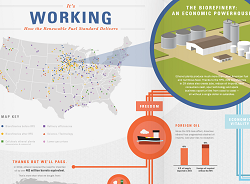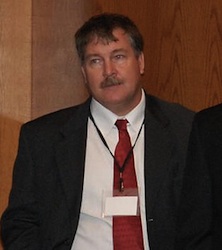 You’ve heard the expression that “a picture tells a thousand words.” Well, some advocates of ethanol believe a well-done picture coupled with compelling facts can tell that thousand words even better (which falls in line with our latest ZimmComm poll results about infographics). American Coalition for Ethanol (ACE) members are gathering this week as they “Unite and Ignite” for this year’ 26th annual conference in Des Moines, Iowa, and hopefully, they’re armed to tell ethanol’s story with an engaging infographic touting the Renewable Fuel Standard (RFS) developed by Greg Veerman’s Astronaut Brand Studio:”An American Success.”
You’ve heard the expression that “a picture tells a thousand words.” Well, some advocates of ethanol believe a well-done picture coupled with compelling facts can tell that thousand words even better (which falls in line with our latest ZimmComm poll results about infographics). American Coalition for Ethanol (ACE) members are gathering this week as they “Unite and Ignite” for this year’ 26th annual conference in Des Moines, Iowa, and hopefully, they’re armed to tell ethanol’s story with an engaging infographic touting the Renewable Fuel Standard (RFS) developed by Greg Veerman’s Astronaut Brand Studio:”An American Success.”
“There are a lot of smart people in this industry who have been serving up a laundry list of features and benefits behind ethanol and the technology, and it’s been kind of a repeated script. What we’re trying to do with the infographic we developed is to use design as a tool,” Greg told Joanna during ACE’s Beltway Biofuels March earlier this year, as about 70 ethanol advocates descended on the nation’s capital to talk with lawmakers. “Design is meant to solve problems, and that’s what we’re doing here with the infographic, [reframing] those features and benefits in a way that engages the audience.”
 Greg went on to say that this infographic helps cut through the noise, and it invites exploration by the reader, giving more visual energy than a white paper, without replacing the necessity and information of a white paper but giving people a chance to better relate to the data.
Greg went on to say that this infographic helps cut through the noise, and it invites exploration by the reader, giving more visual energy than a white paper, without replacing the necessity and information of a white paper but giving people a chance to better relate to the data.
He continued, pointing out that many of the arguments against ethanol are predictable. But he believes if ethanol advocates are able to use the infographic and the facts behind it, they’ll sway audiences because there are some real compelling reasons to support the green fuel. It just needs to be told properly.
“We need to wrap our data with the human dimension and the human benefits that this industry has delivered to so many communities all over the country … and not just in the cornbelt. There are people paying their bills and putting food in their cupboards who are working on the science, the biotechnology and the engineering, and I think the personal human dimension and benefit that represents for American families really in every state is a critical component to this.”
Listen to Joanna’s interview with Greg here: Greg Veerman, Astronaut Brand Studio










